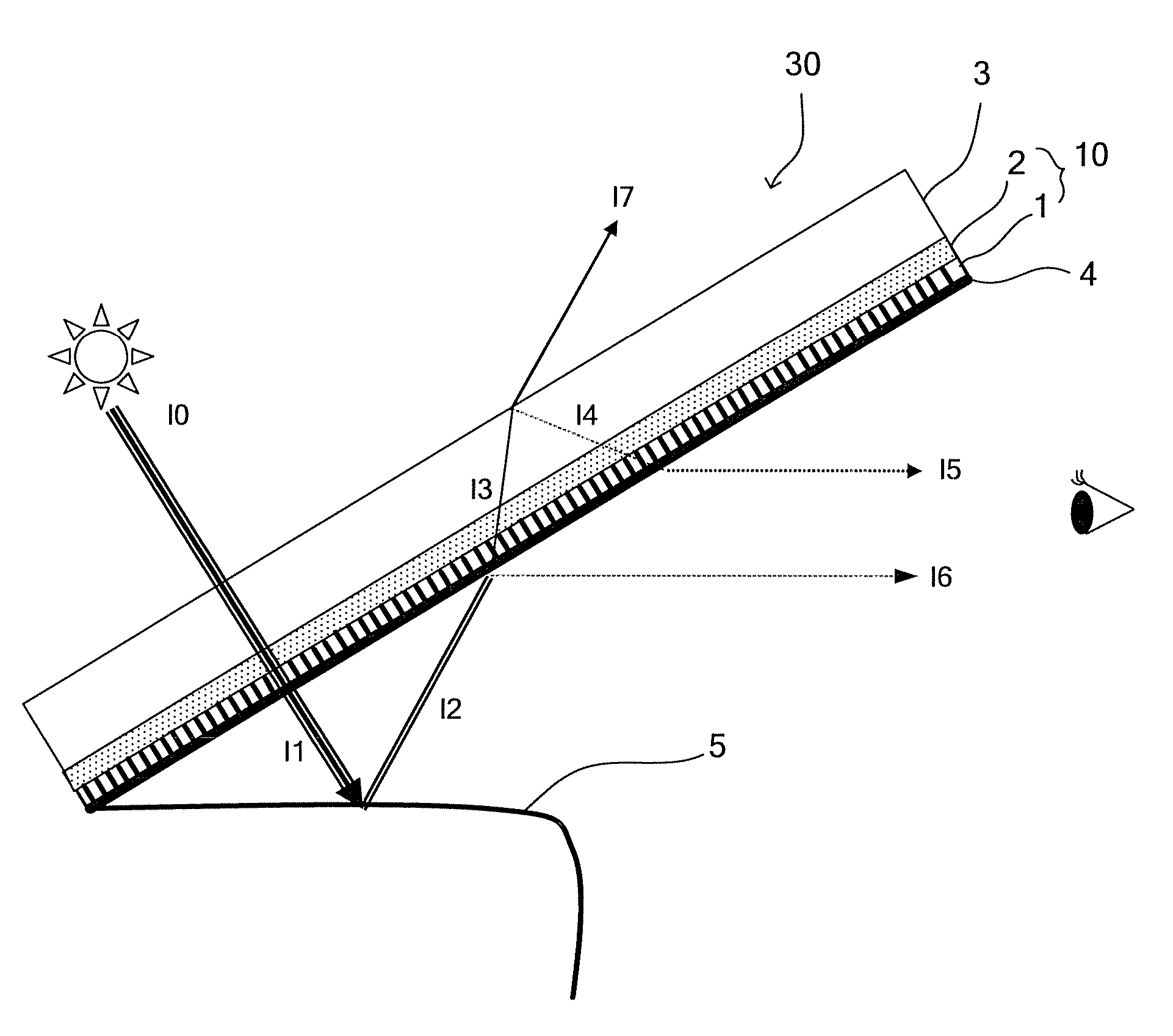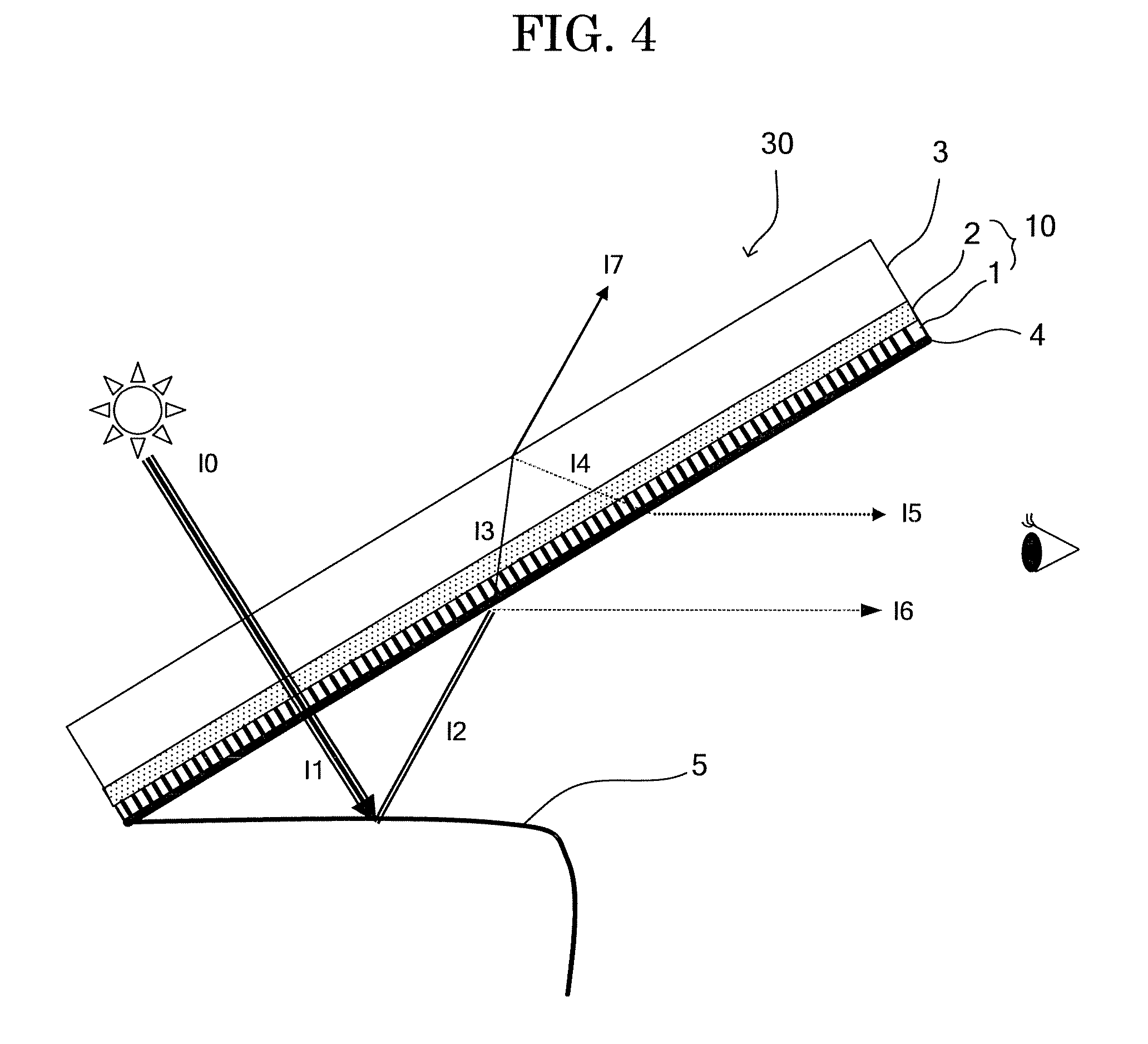Optical film, and glass
a technology of optical film and glass, applied in the field of optical film, can solve the problems of ineffective strong unwanted reflections, and inability to achieve sufficient prevention of unwanted reflections obliquely in front of the windshield and side window glasses, etc., to achieve excellent prevention of unwanted reflections, improve the anti-reflection effect of an interior surface, and flexible design
- Summary
- Abstract
- Description
- Claims
- Application Information
AI Technical Summary
Benefits of technology
Problems solved by technology
Method used
Image
Examples
example 1
Production of Optical Film
—Preparation of Vertically Polarizing Film—
[0244]To a liquid crystal solution prepared by dissolving 3.04 g of a liquid crystal compound having a photo-polymerizable group (PALIOCOLOR LC242, manufactured by BASF) and 0.1 g of a polymer surfactant (MEGAFAC F780F by Dainippon Ink and Chemicals, Inc.) in 5.07 g of methyl ethyl ketone (MEK), 1.11 g of an initiator solution prepared by dissolving 0.90 g of IRGACURE 907 (manufactured by Chiba Specialty Chemicals K.K.) and 0.30 g of KAYACURE DETX (manufactured by Nippon Kayaku Co., Ltd.) in 8.80 g of methyl ethyl ketone (MEK), was added and stirred for 5 minutes to be fully dissolved, thereby obtaining a coating solution for vertically polarizing film.
[0245]Next, onto a surface of a 100 mm×100 mm triacetyl cellulose (TAC) film (TD80U by FUJIFILM CORPORATION) where a PVA orientation film was to be deposited, 10 mass % aqueous solution of polyvinyl alcohol (MP203 by Kuraray Co., Ltd.) was applied by spin coating at ...
example 2
Production of Optical Film
[0253]An optical film of Example 2 was produced in the same manner as in Example 1, except that 5 mass % of HAuCl4.3H2O (by Kanto Chemical Co., Inc) in a methyl ethyl ketone solution in the vertically polarizing film of Example 1 was replaced with 5 mass % of AgNO3 (by Kanto Chemical Co., Inc) in a dimethylacetamide solution.
[0254]When a section of the obtained vertically polarizing film, which was a part of the optical film of Example 2 was observed using a transmission electron microscope (TEM) (JEM-2010 by JEOL Ltd.), Ag nanorods were substantially vertically oriented relative to a base surface. The Ag nanorods had an average aspect ratio (major axis length / minor axis length) of 2.8.
example 3
Production of Optical Film
[0255]An optical film of Example 3 was produced in the same manner as in Example 1, except that the liquid crystal compound in the vertically polarizing film in Example 1 was change from LC242 to RM257 (by Merk Ltd.).
[0256]When a section of the obtained vertically polarizing film, which was a part of the optical film of Example 3 was observed using a transmission electron microscope (TEM) (JEM-2010 by JEOL Ltd.), Au nanorods were substantially vertically oriented relative to a base surface. The Au nanorods had an average aspect ratio (major axis length / minor axis length) of 2.7.
PUM
| Property | Measurement | Unit |
|---|---|---|
| Angle | aaaaa | aaaaa |
| Angle | aaaaa | aaaaa |
Abstract
Description
Claims
Application Information
 Login to View More
Login to View More - R&D
- Intellectual Property
- Life Sciences
- Materials
- Tech Scout
- Unparalleled Data Quality
- Higher Quality Content
- 60% Fewer Hallucinations
Browse by: Latest US Patents, China's latest patents, Technical Efficacy Thesaurus, Application Domain, Technology Topic, Popular Technical Reports.
© 2025 PatSnap. All rights reserved.Legal|Privacy policy|Modern Slavery Act Transparency Statement|Sitemap|About US| Contact US: help@patsnap.com



